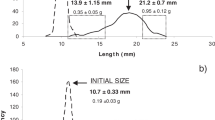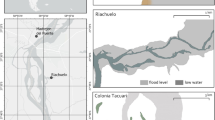Abstract
In autumn 1989 several adultPhiline aperta (L.) were collected in the Øresund near Helsingør. Their larvae were reared from hatching to metamorphosis and maximum growth recorded in terms of shell length. The growth pattern was characterised by three phases: (1) an initial high growth phase based in part on reserves from the egg, with a low rate of algal ingestion; (2) a fast growing phase based on planktotrophy; (3) a settling phase (pediveliger) immediately prior to metamorphosis, with a low growth rate. Larvae of different ages were fed increasing concentrations of the flagellateIsochrysis cf.galbana to study functional relationships of grazing vs food concentration. Maximum ingestion (estimated from the functional relationship experiments) could only meet the costs for growth (estimated from literature growth efficiencies) of the largest larvae. Maximum clearance was allometrically related to larval size. Velar circumference increased isometrically with body size during development, and the length of the compound prototrochal and mesotrochal cilia increased 5 and 2.5 times, respectively. Relations between grazing and velar morphology indicate that both the mesotroch and the prototroch determine the rate of grazing.
Similar content being viewed by others
Literature cited
Anger, K., Anger, V., Hagmeier, E. (1986). Laboratory studies on larval growth ofPolydora ligni, Polydora ciliata, andPygospio elegans (Polychaeta, Spionidae). Helgoländer Meeresunters. 40: 377–395
Bailey, N. T. J. (1959). Statistical methods in biology. The English Universities Ltd, London
Bayne, B. L. (1983). Physiological ecology of marine molluscan larvae. In: Bayne, B. L. (ed.) The mollusca, Vol. 3, Development. Academic Press, London, p. 299–343
Blanner, P. (1982). Composition and seasonal variation of the zooplankton in the Limfjord (Denmark) during 1973–1974. Ophelia 21(1): 1–40
Brown, H. H. (1934). A study of a tectibranch gasteropod molluscPhiline aperta (L.). Trans. R. Soc. Edinb. 58(1): 178–210
Crisp, D. J. (1974). Energy relations of marine invertebrates larvae. Thalassia jugosl. 10(1/2): 103–120
Crisp, D. J., Yule, A. B., White, K. N. (1985). Feeding by oyster larvae: the functional response, energy budget and a comparison with mussel larvae. J. mar. biol. Ass. U. K. 65: 759–783
Daro, M. H., Polk, P. (1973). The autecology ofPolydora ciliata along the Belgian coast. Neth. J. Sea Res. 6(1/2): 130–140
Dobberteen, R. A., Pechenik, J. A. (1987). Comparison of larval bioenergetics of two marine gatropods with widely differing lengths of planktonic life,Thais haemastoma canaliculata (Gray) andCrepidula fornicata (L). J. exp. mar. Biol. Ecol. 109: 173–191
Ewart, J. E., Epifanio, C. E. (1981). A tropical flagellate food for larvae and juvenile oysters,Crassostrea viginica Gmelin. Aquaculture, Amsterdam 22: 297–300
Fenchel, T. (1986). Protozoan filter feeding. Prog. Protistology 1: 65–113
Franz, D. R. (1975). Opisthobranch culture. In: Smith, W. L., Chanley, M. H. (eds.) Culture of marine invertebrate animals. Plenum Press, New York, p. 245–256
Fritz, L. W., Lutz, R. A., Foote, M. A., Dover, C. L. V., Ewart, J. W. (1984). Selective feeding and grazing rates of oyster (Crassostrea virginica) larvae on natural phytoplankton assemblages. Estuaries 7(48): 513–518
Frost, B. W. (1972). Effects of size and concentration of food particles of the feeding behaviour of the marine planktonic copepodCalanus pacificus. Limnol. Oceanogr. 17(6): 805–815
Gerdes, D. (1983). The pacific oysterCrassostrea gigas part I. Feeding behaviour of larvae and adults. Aquaculture, Amsterdam 31: 195–219
Guillard, R. R. L., Ryther, J. H. (1962). Studies of marine planktonic diatoms I.Cyclotella nana Hustedt, andDetonula confervacea (Cleve) Gran. Can. J. Microbiol. 8: 229–239
Hansen, B. (in press). Feeding behaviour in larvae of the opisthobranchPhiline aperta. II. Food size spectra and particle selectivity in relation to larval behaviour and morphology of the velar structures. Mar. Biol.
Hansen, B., Hansen, P. J., Nielsen, T. G. (in press). Effects of large non-grazable particles on clearance and swimming behaviour of zooplankton. J. exp. mar. Biol. Ecol.
Harrigan, J. F., Alkon, D. L. (1978). Larval rearing, metamorphosis, growth and reproduction of the eolid nudibranchHermissenda crassicornis (Eschscholtz, 1831) (Gastropoda: Opisthobranchia). Biol. Bull. mar. biol. Lab., Woods Hole 154: 430–439
Horikoshi, M. (1967). Reproduction, larval features and life history ofPhiline denticulata (J. Adams) (Mollusca — Tectibranchia). Ophelia 4: 43–84
Horsted, S. J., Nielsen, T. G., Riemann, B., Pock-Steen, J., Bjørnsen, P. K. (1988). Regulation of zooplankton by suspension feeding bivalves and fish in estuarine enclosures. Mar. Ecol. Prog. Ser. 48: 217–224
Jespersen, H., Olsen, K. (1982). Bioenergetics in veliger larvae ofMytilus edulis L. Ophelia 21(1): 101–113
Jørgensen, C. B. (1981). Mortality, growth, and grazing impact of a cohort of bivalve larvae,Mytilus edulis L. Ophelia 20(2): 185–192
Larsen, J. B., Bjørnsen, P. K., Hansen, O. G., Olesen, M. (1985). Provisional investigations on the pelagic carbon flow in open Danish waters. Rep. Mar. Pollution Lab. 8: 1–49
Malouf, R. E., Breese, W. P. (1977). Food consumption and growth of larvae of the Pacific oyster,Crassostrea gigas (Thunberg), in a constant flow rearing system. Proc. natn. Shellfish Ass. 67: 7–16
McEdward, L. R. (1984). Morphometric and metabolic analysis of the growth and form of an echinopluteus. J. exp. mar. Biol. Ecol. 82: 259–287
Nicolaisen, H. (1982). Seasonal abundance and composition of mesozooplankton in Danish seas during 1979–1981. Rep. Mar. Pollution Lab. 4: 31
Olson, R. R., Bosch, I., Pearse, J. S. (1987). The hypothesis of antarctic larval starvation examined for the asteroidOdonaster validus. Limnol. Oceanogr. 32(3): 686–690
Pauley, G., Boring, L., Strathmann, R. R. (1985). Food limited growth and development of larvae: experiments with natural sea water. J. exp. mar. Biol. Ecol. 93: 1–10
Pechenik, J. A. (1980). Growth and energy balance during the larval lives of three prosobranch gastropods. J. exp. mar. Biol. Ecol. 44: 1–28
Pechenik, J. A. (1987). Environmental influences on larval survival and development. In: Giese, A. C., Pearse, J. S., Pearse, V. B. (eds.) Reproduction of marine invertebrates, Vol. 9. Blackwell Scientific Publications, Palo Alto, California, p. 551–608
Pechenik, J. A. (1990). Delayed metamorphosis by larvae of benthic marine invertebrates: Does it occur? Is there a price to pay? Ophelia 32(1–2): 63–94
Pechenik, J. A., Fischer, N. (1979). Feeding, assimilation, and growth of mud snail larvae,Nassarius obsoletus (Say), on three different algal diets. J. exp. mar. Biol. Ecol. 38: 57–80
Perron, F. E. (1980). Laboratory culture of the larvae ofConus textile Linné (Gastropoda: Toxoglossa). J. exp. mar. Biol. Ecol. 42: 27–38
Rhodes, E. W., Landers, W. S. (1973). Growth of oyster larvae,Crassostrea virginica, of various sizes in different concentrations of the chrysophyte,Isochrysis galbana. Proc. natn. Shellfish Ass. 63: 53–59
Riisgård, H. U. (1988). Feeding rates in hard clam (Mercenaria mercenaria) veliger larvae as a function of algal (Isochrysis galbana) concentration. J. Shellfish Res. 7(3): 377–380
Riisgård, H. U., Randløv, A., Hamburger, K. (1981). Oxygen consumption and clearance as a function of size inMytilus edulis L veliger larvae. Ophelia 20(2): 179–183
Riisgård, H. U., Randløv, A., Kristensen, P. S. (1980). Rates of water processing, oxygen consumption and efficiency of particle retention in veligers and young post-metamorphicMytilus edulis. Ophelia 19(1): 37–47
Schram, T. A. (1968). Studies on the meroplankton in the inner Oslofjord I. Composition of the plankton at Nakkholmen during a whole year. Ophelia 5: 221–243
Sprung, M. (1984a). Physiological energetics of mussel larvae (Mytilus edulis). II. Food uptake. Mar. Ecol. Prog. Ser. 17: 295–305
Sprung, M. (1984b). Physiological energetics of mussel larvae (Mytilus edulis). I. Shell growth and biomass. Mar. Ecol. Prog. Ser. 17: 283–293
Strathmann, R. R., Jahn, T. L., Fonseca, J. R. C. (1972). Suspension feeding by marine invertebrate larvae: clearance of particles by ciliated bands of a Rotifer, Pluteus, and Trochophore. Biol. Bull. mar. biol. Lab., Woods Hole 142: 505–519
Strathmann, R. R., Leise, E. (1979). On feeding mechanisms and clearance rates of molluscan veligers. Biol. Bull. mar. biol. Lab., Woods Hole 157: 524–535
Switzer-Dunlap, M., Hadfield, M. G. (1977). Observations on development, larval growth and metamorphosis of four species of aplysidae (Gastropoda: Opisthobranchia) in laboratory culture. J. exp. mar. Biol. Ecol. 29: 245–261
Thompson, T. E., Brown, G. H. (1976). British opisthobranch molluscs, Mollusca: Gastropoda. Keys and notes for the identification of the species. The Linnean Society of London. Academic Press, London
Thorson, G. (1946). Reproduction and larval developments of Danish marine bottom invertebrates. Meddr. Komm. Danm. Fisk.-og. Havunders 4(1): 521
Thorson, G. (1950). Reproductive biology and larval ecology of marine bottom invertebrates. Biol. Rev. 25: 1–45
Thorson, G. (1964). Light as an ecological factor in the dispersion and settlement of larvae of marine bottom invertebrates. Ophelia 1: 167–208
Todd, C. D., Bentley, M. G., Havenhand, J. N. (1991). Larval metamorphosis of the opisthobranch molluscAdalaria proxima (Gastropoda: Nudibranchia): the effects of choline and elevated potassium ion concentration. J. mar. biol. Ass. U.K. 71: 53–72
Walne, P. R. (1965). Observations on the influence of food supply and temperature on the feeding and growth of the larvae ofOstrea edulis L. Fishery Invest., Lond. (Ser. 2) 24(1): 1–45
Williams, L. G. (1980). Development and feeding of larvae of the nudibranch gastropodsHermissenda crassicornis andAeolidia papillosa. Malacologia 20(1): 99–116
Wilson, J. H. (1979). Observations on the grazing rates and growth ofOstrea edulis L. larvae when fed algal cultures of different ages. J. exp. mar. Biol. Ecol. 38: 187–199
Wilson, J. H. (1980). Particle retention and selection by larvae and spat ofOstrea edulis in algal suspensions. Mar. Biol. 57: 135–145
Author information
Authors and Affiliations
Additional information
Communicated by T. Fenchel, Helsingør
Rights and permissions
About this article
Cite this article
Hansen, B., Ockelmann, K.W. Feeding behaviour in larvae of the opisthobranchPhiline aperta . Mar. Biol. 111, 255–261 (1991). https://doi.org/10.1007/BF01319707
Accepted:
Issue Date:
DOI: https://doi.org/10.1007/BF01319707




